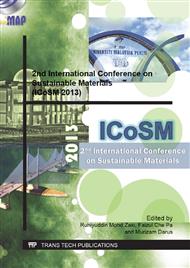[1]
Chen, Z.W., et al., Microstructural evolution of oxides and semiconductor thin films. Progress in Materials Science. 56(7): pp.901-1029.
Google Scholar
[2]
Pennelli, G., Conduction of metalâ€"isolatorâ€"semiconductor structures with granular silicon thin films. Thin Solid Films, 1999. 348(1â€"2): pp.157-164.
DOI: 10.1016/s0040-6090(99)00058-9
Google Scholar
[3]
Drummond, P.J., et al., Studies of photoconductance decay method for characterization of near-surface electrical properties of semiconductors. Thin Solid Films. 519(22): pp.7621-7626.
DOI: 10.1016/j.tsf.2011.04.212
Google Scholar
[4]
Ternon, C., et al., Si/SiO2 multilayers: synthesis by reactive magnetron sputtering and photoluminescence emission. Physica E: Low-dimensional Systems and Nanostructures, 2003. 16(3-4): pp.517-522.
DOI: 10.1016/s1386-9477(02)00632-x
Google Scholar
[5]
Song, C., et al., Structural and electronic properties of Si nanocrystals embedded in amorphous SiC matrix. Journal of Alloys and Compounds, 2011. 509(9): pp.3963-3966.
DOI: 10.1016/j.jallcom.2010.12.191
Google Scholar
[6]
Sree Harsha, K.S., Evaporation, in Principles of Vapor Deposition of Thin Films (First Edition). 2005, Elsevier: Oxford. pp.11-143.
DOI: 10.1016/b978-008044699-8/50002-4
Google Scholar
[7]
SreeHarsha, K.S., Principles of physical vapor deposition of thin films. 2006: Elsevier.
Google Scholar
[8]
Astling, M., et al., Ferroelectric thin films on silicon carbide for next-generation nonvolatile memory and sensor devices. Thin Solid Films, 2004. 469â€"470(0): pp.444-449.
DOI: 10.1016/j.tsf.2004.09.030
Google Scholar
[9]
Drummond, P., A. Kshirsagar, and J. Ruzyllo, Characterization of near-surface electrical properties of multi-crystalline silicon wafers. Solid-State Electronics. 55(1): pp.29-36.
DOI: 10.1016/j.sse.2010.09.005
Google Scholar
[10]
Henini, M., et al., Electrical and optical properties of self-assembled quantum dots. Microelectronics Journal, 2002. 33(4): pp.313-318.
DOI: 10.1016/s0026-2692(01)00124-0
Google Scholar
[11]
Sakrani, S., et al., The Growth Mechanism of Silicon Nanodots Synthesized by Sputtering Method. AIP Conference Proceedings, 2011. 1341(1): pp.109-113.
Google Scholar
[12]
Idrees, F.A., S. Sakrani, and Z. Othaman, Formation and Characterization of Silicon Self-assembled Nanodots. AIP Conference Proceedings, 2011. 1341(1): pp.324-327.
DOI: 10.1063/1.3587011
Google Scholar
[13]
Chen, W.-Y., et al., Optical properties of stacked Ge/Si quantum dots with different spacer thickness grown by chemical vapor deposition. Applied Surface Science, 2004. 224(1-4): pp.148-151.
DOI: 10.1016/j.apsusc.2003.08.040
Google Scholar


